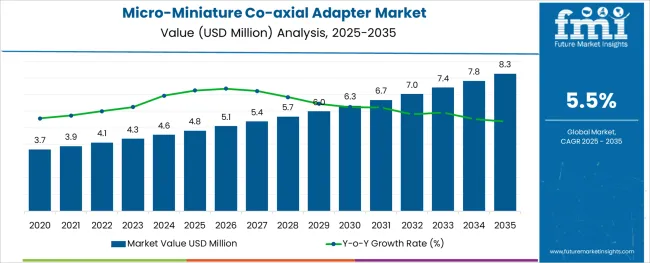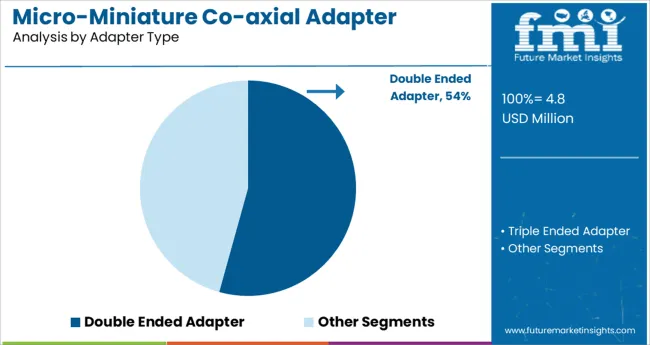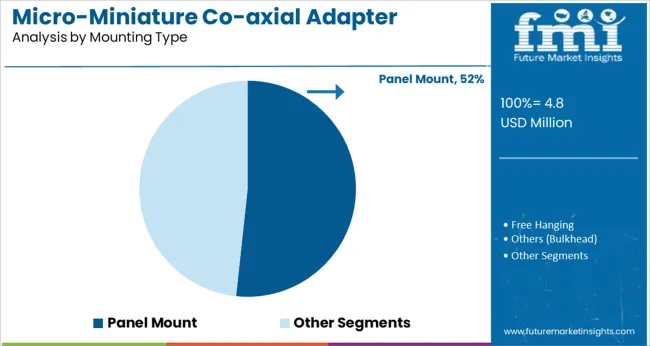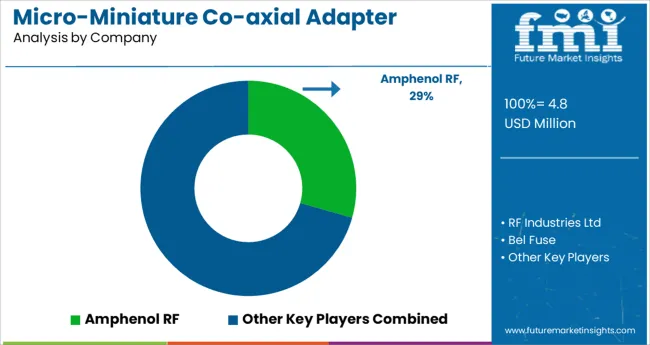The Micro-Miniature Co-axial Adapter Market is estimated to be valued at USD 4.8 million in 2025 and is projected to reach USD 8.3 million by 2035, registering a compound annual growth rate (CAGR) of 5.5% over the forecast period.

The micro-miniature co-axial adapter market is progressing steadily due to rising demand for compact, high-performance connectivity solutions in electronics and communication sectors. Advances in miniaturization and the need for reliable high-frequency signal transmission have driven the adoption of these adapters. Industry focus on optimizing space in devices such as mobile equipment, aerospace systems, and medical instruments has further fueled market growth.
Innovations in design and materials have improved adapter durability and signal integrity, encouraging widespread use. Growing application diversity, from test and measurement equipment to wireless infrastructure, has expanded market opportunities.
Continued technological development and increasing deployment of high-frequency communication systems suggest strong future growth. Segment growth is anticipated to be led by double-ended adapters as the preferred adapter type, straight adapters dominating product shape and orientation, and panel mount solutions favored for mounting type due to their versatility in device integration.
The market is segmented by Adapter Type, Product Shape/Orientation, Mounting Type, Conversion Type, and Application and region. By Adapter Type, the market is divided into Double Ended Adapter and Triple Ended Adapter. In terms of Product Shape/Orientation, the market is classified into Straight, Right Angled, and T-Shaped. Based on Mounting Type, the market is segmented into Panel Mount, Free Hanging, and Others (Bulkhead). By Conversion Type, the market is divided into Between Series (MMCX to SMA, MMCX to MCX and Others) and Same Series (MMCX to MMCX). By Application, the market is segmented into Test & Measurement Equipment, Antenna Mount, Panel Transition, Radio Board, and Others (System Bulkhead Applications). Regionally, the market is classified into North America, Latin America, Western Europe, Eastern Europe, Balkan & Baltic Countries, Russia & Belarus, Central Asia, East Asia, South Asia & Pacific, and the Middle East & Africa.
The market is segmented by Adapter Type, Product Shape/Orientation, Mounting Type, Conversion Type, and Application and region. By Adapter Type, the market is divided into Double Ended Adapter and Triple Ended Adapter. In terms of Product Shape/Orientation, the market is classified into Straight, Right Angled, and T-Shaped. Based on Mounting Type, the market is segmented into Panel Mount, Free Hanging, and Others (Bulkhead). By Conversion Type, the market is divided into Between Series (MMCX to SMA, MMCX to MCX and Others) and Same Series (MMCX to MMCX). By Application, the market is segmented into Test & Measurement Equipment, Antenna Mount, Panel Transition, Radio Board, and Others (System Bulkhead Applications). Regionally, the market is classified into North America, Latin America, Western Europe, Eastern Europe, Balkan & Baltic Countries, Russia & Belarus, Central Asia, East Asia, South Asia & Pacific, and the Middle East & Africa.

The double-ended adapter segment is expected to capture 54.3% of the market revenue in 2025, leading the adapter type categories. This preference has resulted from the versatility double-ended adapters offer by connecting two coaxial cables or devices with compatible connectors directly. Their compact design facilitates efficient signal transmission with minimal loss, making them suitable for high-frequency applications.
Manufacturers have leveraged double-ended adapters for their ease of installation and reliability in demanding environments. The growing demand in telecommunications and test equipment, where flexible connectivity is essential, has reinforced this segment’s position.
As device complexity increases and space constraints become critical, double-ended adapters will likely continue to be favored.
The straight adapter segment is projected to represent 48.6% of the market revenue in 2025, holding dominance in product shape and orientation. Straight adapters are widely preferred due to their simplicity and ability to maintain signal integrity without introducing bends or impedance mismatches.
Their design supports straightforward cabling layouts and is commonly used in confined spaces where a direct connection is required. The ease of manufacturing and compatibility with standard coaxial interfaces contribute to their widespread adoption.
With increasing integration of compact electronic systems, straight adapters provide a reliable and efficient solution, sustaining their leading market share.

The panel mount segment is projected to account for 51.7% of the micro-miniature co-axial adapter market revenue in 2025, establishing it as the leading mounting type. Panel mount adapters offer convenient and secure installation on equipment panels and instrument enclosures, enhancing accessibility and durability.
Their widespread use in communication devices, test instruments, and aerospace applications has driven demand. The mounting style facilitates easy maintenance and replacement, which is crucial for minimizing downtime in critical systems.
Additionally, the robust mechanical connection provided by panel mounts supports reliable signal transmission in vibration-prone environments. As electronic equipment continues to evolve with modular designs, panel mount adapters will remain essential for effective system integration.
Themicro-miniature co-axial adapter marketis classified based on type, vertical, application area, and region.
MMCX to AMC, MMCX to MMCX, MMCX to N, MMCX to SMA, MMCX to BNC, and MMCX to MCX are the different types of micro-miniature co-axial adapters.
The gender design of these adapter types can be further divided into the jack to jack, jack to plug, plug to plug, and plug to plug
Based on vertical, the micro-miniature co-axial adapter market can be segmented into sectors, the healthcare sector, the manufacturing sector, the public sector, and others.
The micro-miniature co-axial adapter market can be divided into test and measurementequipment, antenna mounts, panel transitions, radio boards, and system bulkhead applications based on the application area.
Themicro-miniature co-axial adapter marketis segmented into North America, Latin America, Western Europe, Eastern Euro pe, Japan, Asia-Pacific excluding Japan (APEJ), and the Middle East and Africa (MEA).
APEJ is expected to hold a substantialmicro-miniature co-axial adapter market shareamong all the regions during the forecast period.
The ever-increasing popularity of smart and inter-connected devices in personal as well as professional usage is expected to be the key driver for thedemand for micro-miniature co-axial adaptersduring the forecast period.
Also, further enhancement in wireless and radio frequency communication technologies will further support thesales of micro-miniature co-axial adaptersglobally.
Demand for micro-miniature co-axial adapterslikely dwindles due to lack of awareness across industries, especially in emerging markets such as India, Africa, Brazil and Argentina, of micro-miniature co-axial adapter market.
The emergence of regional rival companies is expected to negatively affect thesales of micro-miniature co-axial adapterson a global scale during the forecast period.
The increasing raw material prices can be further expected to hinder thedemand formicro-miniature co-axial adaptersand cause concerns for thesales of micro-miniature co-axial adaptersaround the globe.
Key players in the globalmicro-miniature co-axial adapter marketfocus on introducing advanced products and services to improve the overallsales of micro-miniature co-axial adaptersand strengthen their position in the market.
For example, Amphenol RF introduced an adapter, i.e., APH-SMAJ-MMCXJ, which offers an SMA jack to MMCX jack connection and a resistance of 50 ohms.

The key players in the globalmicro-miniature co-axial adapter marketinclude Amphenol RF Asia Corp.,, Emerson Network Power Inc., Huber+Suhner Inc., Cinch Connectivity Solutions LTD., RF Industries LTD, Dynawave Inc., Tyco Electronics Corporation, Bomar Interconnect Products Inc. and others.
| Report Attributes | Details |
|---|---|
| Growth rate | CAGR of 5.5% from 2025 to 2035 |
| Base year for estimation | 2024 |
| Historical data | 2020 to 2024 |
| Forecast period | 2025 to 2035 |
| Quantitative units | Revenue in USD million and CAGR from 2025 to 2035 |
| Report coverage | Revenue forecast, volume forecast, company ranking, competitive landscape, growth factors, and trends, Pricing Analysis, |
| Segments covered | Type, Application, Region |
| Regional scope | North America; Western Europe; Eastern Europe; Middle East; Africa; ASEAN; South Asia; Rest of Asia; Australia and New Zealand |
| Country scope | USA, Canada, Mexico, Germany, UK, France, Italy, Spain, Russia, Belgium, Poland, Czech Republic, China, India, Japan, Australia, Brazil, Argentina, Colombia, Saudi Arabia, UAE, Iran, South Africa |
| Key companies profiled | Amphenol RF Asia Corp.; Emerson Network Power Inc.; Huber+Suhner Inc.; Cinch Connectivity Solutions LTD.; RF Industries LTD; Dynawave Inc.; Tyco Electronics Corporation; Bomar Interconnect Products Inc. and other. |
| Customization scope | Free report customization (equivalent to up to 8 analysts working days) with purchase. Addition or alteration to country, regional & segment scope. |
| Pricing and purchase options | Avail customized purchase options to meet your exact research needs. |
The global micro-miniature co-axial adapter market is estimated to be valued at USD 4.8 million in 2025.
It is projected to reach USD 8.3 million by 2035.
The market is expected to grow at a 5.5% CAGR between 2025 and 2035.
The key product types are double ended adapter and triple ended adapter.
straight segment is expected to dominate with a 48.6% industry share in 2025.






Full Research Suite comprises of:
Market outlook & trends analysis
Interviews & case studies
Strategic recommendations
Vendor profiles & capabilities analysis
5-year forecasts
8 regions and 60+ country-level data splits
Market segment data splits
12 months of continuous data updates
DELIVERED AS:
PDF EXCEL ONLINE
Coaxial Splitters Market Size and Share Forecast Outlook 2025 to 2035
Coaxial Attenuators Market Size and Share Forecast Outlook 2025 to 2035
Coaxial Coupler Market Size and Share Forecast Outlook 2025 to 2035
Coaxial Cable Market Growth & Demand 2025 to 2035
Hybrid Fiber Coaxial Market - Broadband & 5G Growth 2025 to 2035
Multi Coaxial Connectors Market - Growth & Forecast 2025 to 2035
Connector Adapter Kits Market
Bluetooth Adapter Market
AC DC Power Adapter Market Forecast and Outlook 2025 to 2035
Drill Shank Adapter Market Size and Share Forecast Outlook 2025 to 2035
LC Standard Adapters Market Size and Share Forecast Outlook 2025 to 2035
All-in-One LC Adapters Market Size and Share Forecast Outlook 2025 to 2035
Digital Media Adapters Market Size and Share Forecast Outlook 2025 to 2035
LC Fiber Optic Adapters Market Size and Share Forecast Outlook 2025 to 2035
LC Dust Shutter Adapters Market Size and Share Forecast Outlook 2025 to 2035
Multi Dose Drug Vial Adapters Market Size and Share Forecast Outlook 2025 to 2035
Cable Connectors and Adapters Market Analysis by Application, Product, Type and Region: Forecast from 2025 to 2035
Optical EMI Shielding Adapters Market Size and Share Forecast Outlook 2025 to 2035
Automotive EV Charging Adapters Market

Thank you!
You will receive an email from our Business Development Manager. Please be sure to check your SPAM/JUNK folder too.
Chat With
MaRIA